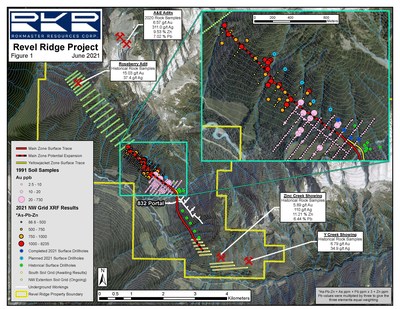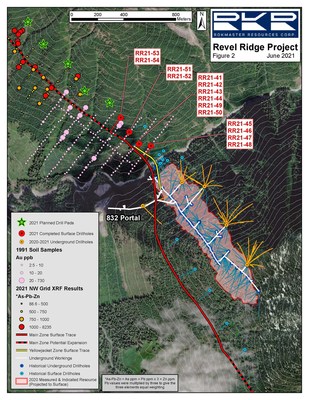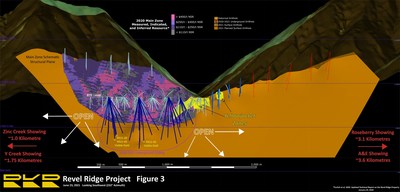You are here
Rokmaster's Extensive Geochemical and Drilling Programs Target Km Scale Orogenic Gold System at Revel Ridge
Rokmaster's Extensive Geochemical and Drilling Programs Target Km Scale Orogenic Gold System at Revel Ridge
Canada NewsWire
VANCOUVER, BC, June 24, 2021
VANCOUVER, BC, June 24, 2021 /CNW/ - Rokmaster Resources Corp. (TSXV: RKR) (OTCQB: RKMSF) (FSE: 1RR1) ("Rokmaster" or the "Company") reports that its ongoing surface diamond drill and geochemical sampling program is providing definitive evidence that the Revel Ridge orogenic gold system exhibits persistent, strong geochemical and structural signatures extending for km's beyond historical diamond drill holes. Ongoing geochemical programs and surface diamond drilling indicates:
A. Geochemical Signatures of Main and Yellowjacket Zones (RRMZ – RRYZ).
- Recently completed soil geochemical surveys conclusively demonstrate that geochemical signatures exist along trend for at least 2.0 km to the northwest of the 830 m Level portal. See Figure 1 – Soil Geochemistry Compilation Map. The location of 1991 Au in soil, along with 2021, As-Pb-Zn soil anomalies may be shown to have a strong linkage to bedrock RRMZ and RRYZ mineralized zones.
- The strength of the As-Pb-Zn geochemical signatures of the gold rich Main Zone and silver rich Yellowjacket zone, obtained from the historical soil geochemical grid, have necessitated major expansion of this grid. Additional soil geochemistry grids have been implemented along strike to the northwest for an additional 2.8 km. The combined Northwest soil geochemical grids have a combined strike length of 4.2 km, all of which lies beyond historic drill testing.
- Structural and geochemical vectors have also been obtained on strike to the southeast of any historic drilling. The Southeastern grid has a strike length of 1.5 km. All of the samples from this grid are currently being processed.
- In total, 880 soil samples have been collected from new soil geochemical grids with a combined strike length of 5.7 km. Results are currently available only over the initial Northwest grid, 259 samples over 1.4 km of strike length. The two grids, Northwest grid extension and Southeast grid are illustrated. No analytical results have been received for the Northwest grid extension or the Southeast grid and as a result no geochemical anomalies are identified. All other results will be released as soon as these data become available.
B. Surface Diamond Drilling: Main and Yellowjacket Zones (RRMZ – RRYZ).
- Currently 14 surface diamond drillholes have been competed for a total of approximately 2,700 m of NQ drilling. Drilling is now being undertaken approximately 500 m to the northwest of the 830 m Level portal. See Figure 2 – Drill Hole Compilation Map.
- The drillholes have been successful in cutting visually significant intersections of both the silver rich Yellowjacket Zone (RRYZ) and the gold rich Main Zone (RRMZ).
- Strong indications of the continuity of mineralization with the Revel Ridge orogenic gold system, obtained from surface drillholes, has permitted Revel Ridge's technical team to increase the spacing between drill "fences". Initially, drill fences were designed on approximately 100 m step-outs; that has currently been increased to approximately 200 m.
- Within the next few weeks, an additional 2.0 km of the strike length of this unique and very robust, orogenic gold system will be drill tested.
- Rokmaster is currently waiting for the receipt of the assay results from surface drillholes. Those results will be released as promptly as possible.
C. The "Big Picture".
The combined soil geochemical and diamond drillhole arrays are shown on a common base map as Figure 3 – Longitudinal Section Graphic and when used in conjunction with Figure 1, these data suggest:
- The current Revel Ridge resource is located in a volume of rock which forms less than 20% of the strike length of the Revel Ridge orogenic gold system.
- The 2021 underground drillholes demonstrate that gold-silver mineralization extends from surface to approximately 1.2 km subsurface. In contrast, the initial surface drillholes are sometimes cutting strong mineralized zones less than 80 m subsurface.
- The initial soil geochemical and diamond drill data suggests that the Revel Ridge orogenic gold system is continuing, unabated and undiminished, for km scale distances relative to historic drilling.
John Mirko, President and CEO of Rokmaster, commented: "The scope, the scale, and quality of the targets within the Revel Ridge deformation zone continues to exceed our expectations. We are expanding exploration beyond where other explorers have gone before, founded on the demonstrable strength of the Revel Ridge orogenic polymetallic gold system. The strength of the soil geochemical anomalies obtained from 5.7 km of additional soil geochemical grids clearly indicates that our confidence in this project is well founded. With the geochemical signatures of this gold system in hand, we are rapidly testing, on broad 200 m plus steps outs, the bedrock source of those anomalies. Our first surface drillholes have repeatedly cut both Yellowjacket and Main Zone style mineralization and cut those zones in a reliable and predictable manner. The data is beginning to suggest that the volume of mineralized rock outside of 2020 resource area (published in Sedar 2021) may be significantly larger than the volume of rock within the 2020 resource domain. A welcome challenge for our team is seizing on the impressive size and growing number of tier-one targets. This is an enviable position for any junior explorer and a position which is likely unique for many projects within the Western Cordillera."
Quality Assurance/Quality Control Soil Samples. Soil samples have been analyzed on site utilizing a portal XRF instrument. These instruments are able to accurately analyze a variety of base metals but will not accurately analyze gold or silver mineralization. XRF testing of soil samples is conducted on site in the following manner:
Sample Vials: The Lab area is thoroughly cleaned and new sample vials are utilized from new, by hand, set aside on a clean surface and covered. Sample bags are retrieved from a detached dry storage room; brought into the lab, arranged in numbered order on the workspace. Vials are labelled accordingly, returned to the clean surface, covered.
Soil preparation: Squeeze/crush sample in the bag to loosen any material adhered to the bag walls during drying. Plunge a clean spoon into the heart of the sample bag to retrieve soil. Pour spoonful (or 2 as required) onto a clean, coarse sieve. Sieve soil sample onto a clean triangle tray. Visually observe sample within the triangle tray for organics and overall sample quality. Re-sieve sample at a smaller mesh (80 mesh) as required. Pour sieved/homogenized sample from triangle tray into pre-constructed and labelled vial. The filled vial is capped and set in labelled sequence on a clean surface, clean tools and repeat. Once each available sample has been vialed, the workspace is cleaned and the XRF analyzer setup.
Analyzation procedure: Undertake a system check, use a triple shot of the provided control sample (#180-706) and determine the 3 shot average. Analyze each available sample in numbered sequence for a total duration of 60 seconds (as per XRF soil testing settings), three times. Once analyzed, the vials are then placed, in sequence, in an enclosed cabinet for future reference. XRF data is exported from the analyzer onto a computer for averaging, interpretation, and plotting.
The technical information contained in this news release has been prepared in accordance with Canadian regulatory requirements as set out in National Instrument 43-101 and reviewed and approved by Mark Rebagliati, P. Eng., FEC, who is independent of Rokmaster.
On behalf of the Board of Directors,
"John Mirko"
John Mirko, President and Chief Executive Officer.
Neither the TSX Venture Exchange nor its Regulation Services Provider (as that term is defined in the policies of the TSX Venture Exchange) accepts responsibility for the adequacy or accuracy of this release.
CAUTIONARY NOTE REGARDING FORWARD LOOKING STATEMENTS:
This news release may contain forward-looking information within the meaning of applicable securities laws ("forward-looking statements"). Forward-looking statements are statements that are not historical facts and are generally, but not always, identified by the words "expects," "plans," "anticipates," "believes," "intends," "estimates," 'projects," "potential" and similar expressions, or that events or conditions "will," "would," "may," "could" or "should" occur. These forward-looking statements are subject to a variety of risks and uncertainties which could cause actual events or results to differ materially from those reflected in the forward-looking statements, including, without limitation: risks related to fluctuations in metal prices; uncertainties related to raising sufficient financing to fund the planned work in a timely manner and on acceptable terms; changes in planned work resulting from weather, logistical, technical or other factors; the possibility that results of work will not fulfill expectations and realize the perceived potential of the Company's properties; risk of accidents, equipment breakdowns and labour disputes or other unanticipated difficulties or interruptions; the possibility of cost overruns or unanticipated expenses in the work program; the risk of environmental contamination or damage resulting from Rokmaster's operations and other risks and uncertainties. Any forward-looking statement speaks only as of the date it is made and, except as may be required by applicable securities laws, the Company disclaims any intent or obligation to update any forward-looking statement, whether as a result of new information, future events or results or otherwise.
SOURCE Rokmaster Resources Corp.

![]() View original content to download multimedia: http://www.newswire.ca/en/releases/archive/June2021/24/c2737.html
View original content to download multimedia: http://www.newswire.ca/en/releases/archive/June2021/24/c2737.html
Please make the indicated changes including the new text: US quotes snapshot data provided by IEX. Additional price data and company information powered by Twelve Data.


